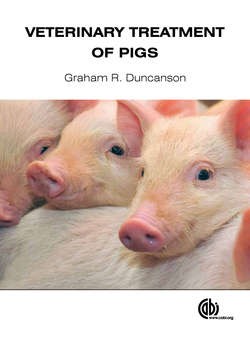Читать книгу Veterinary Treatment of Pigs - Graham R Duncanson - Страница 110
На сайте Литреса книга снята с продажи.
Diagnostic Laboratory Tests Blood sampling
ОглавлениеObtaining blood samples is not easy from any age of pig. Piglets weighing <10 kg are best held in dorsal recumbency on the lap of a sitting person, who holds the front legs firmly with the head towards the veterinary surgeon. The surgeon then holds the piglet’s head in one hand and directs the 25 mm needle from the jugular groove in a caudo-medial direction into the anterior vena cava.
Older pigs are also best bled from the anterior vena cava with the nose held up in a pig snare. The blood vessel cannot be seen or palpated but the needle has to be directed medially from the indentation at the base of the neck.
Only in adults can blood be drawn from the jugular vein. The animal is best restrained in a crate with the head held as high as possible by the snare. The needle must be at least 38 mm long and should be directed at 45° in a dorsomedial direction from the caudal end of the jugular furrow. Blood can be drawn in adults with large ears from an ear vein. A tourniquet of a thick rubber band and a pair of artery forceps is placed at the base of the ear. The small veins can be seen on the outside of the ear between the skin and the cartilage. Blood can be drawn using a 23 mm needle on the end of a syringe to apply a small amount of suction.
Normal haematological and biochemical parameters are given in Tables 3.2 and 3.3.
